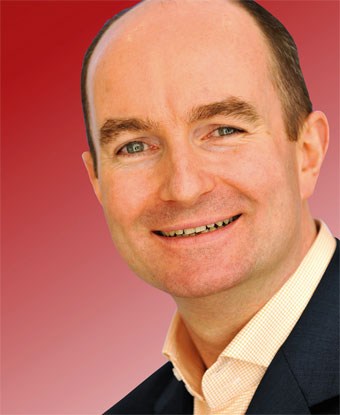It's a small world
Andy McFarlane, head of marketing for Vodafone Global Enterprise, talks to MCI about taking its services beyond operational boundaries.
October 29, 2012

Andy McFarlane, head of marketing for Vodafone Global Enterprise, talks to MCI about taking its services beyond operational boundaries.
Q. How important is an international presence in the enterprise market?
One of the key things to stress is that Vodafone Global Enterprise operates wherever our customers have people, so we are not limited to Vodafone’s own footprint; where we have our own network or where we have partner relationships. Obviously our domestic operations are a really important part of our total global capability but we will work with our customers wherever they have employees.
For example, one of our customers is Unilever, which has employees in 64 different countries across the world. In a number of those countries Vodafone doesn’t have its own operations, so we sit down with Unilever and identify which local player is the operator of choice, to them and to us.
Then we strike a working relationship with that operator based on the products and services of our own that we’re able to offer [over the local network], and connect with that operator so that we can pull together the information and provide Unilever with that full global visibility of their expenditure across the world.
Q. So does this area of business require more flexibility than perhaps operators are used to?
We have a network-agnostic service capability. That is really important because the heritage of our industry is one with very many mobile providers operating on a national basis with national licenses, with nationallyaligned technology. Bringing that together internationally and taking that complexity away is a really important thing for our customers—that’s a critical part of how we provide service and the value that we add.
Q. Do the service requirements vary significantly from market to market?
The world nowadays is less defined by significant regional variances. The differences are more companyby- company than market-by-market. Some organisations have very tight consistent global procurement processes, other organisations are less globally integrated and might have nationally- or regionally-focused purchasing approaches. So we will work however our customers want to work and we will align our teams wherever our customers want us to be. We deliberately put our people in the countries of operation of our customers and we have them serve our customers either on a national basis, or a regional basis, or a global basis, depending on the nature of operation of that company in that country.
Q. And in terms of the services themselves?
It’s different by company and by contract type; Sometimes we might get involved in really big international rollouts for a relatively wide piece of our offering. Alternatively, we might get involved in co-creating a unique solution that is specific to an individual client in a market where maybe they want to try a new technology or differentiate the way their products go to market. So it’s quite a complicated picture across different markets, different clients and different types of solution. It’s a fascinatingly diverse range of business relationships that we have.
But broadly there are three ways that we deliver value to our customers: There are things that we can do to help their employees be more productive, there are things we can do at an international level to help them manage their business more effectively or there are things that we can do to help them grow their business, or change the way that they serve their customers. Q. Can you explain in more depth how you can improve customers’ business management?
It might start simply with providing full visibility of the communications services they are using, whether those services are with Vodafone or a whole range of different services providers across fixed and mobile and across the world. We have what Gartner recognised as the world’s leading telecoms management expense practice and—it might sound simple—but to have that single cost figure on the table for the finance team and procurement team to look at can be a really important starting point in our relationship with a client. It enables them to plan their investment over the coming two to three years.
Q. So is cost still more important than, say, the delivery of new services to employees?
It’s not just about delivering on the needs of the employee, although that’s very important and a broad range of employees have a broad range of needs. It’s also about making sure that you are delivering global visibility and control—management control of that full telecoms state in a secure, robust and reliable way, so that the global CIO feels very comfortable with the diverse set of tools that are out there. That’s very powerful when you get that right; employees get what they want, they can use the tools of choice depending on the kind of work they want to do on a day by day basis, and the CIO gets full visibility of the costs and what is going on across the network. Q. Does Vodafone develop in-house tools for these solutions? We offer a range of tools, most often some form of mobile device management. We work with each of the providers of device management software and we don’t have our own in-house MDM software. We can help the customer select the best one for them, given what else they’ve got going on in their IT infrastructure and how they want to evolve their IT strategy—be it in the cloud, on premises, or some other configuration.
Q. And business growth?
This will be more around how we can do something, more often than not with mobile technology, that changes the way the client goes to market. It’s about embedding our technology into other companies’ offerings to help them differentiate their products. So it might be around our M2M capability. M2M is a very exciting area. There are a number of applications that are changing the consumer experience but without a shadow of a doubt M2M is enabling companies to change the way in which the manage processes—supply chain or logistics, for example.
Q. Has that kind of technology reached true maturity now?
The great advantage of technology through the investments that Vodafone has made is that we’re enabling very different things to be done now, rather than waiting for the capability. Networks and bandwidth are way ahead of where they were just five years ago, smartphones are widespread and M2M, as I mentioned, is way more advanced. The combination of those things is very powerful. I’ve been in the ICT sector for almost 20 years and for the first time ever I’m now able to have a conversation with pretty much any company about what they want to do and the technology is not the limitation.
The technology can pretty well do anything at a sensible cost level. Now it’s a matter of where the innovation and the breakthrough thinking is going to come from within the customer and how the technology gets applied to that thinking so that the customer can do something really powerful.
Q. So what standout examples of innovation have you seen?
There’s a whole range of examples but I can take just one sector and provide a couple of different examples. Some of the companies we’re working with in the healthcare and medical technology sector are fundamentally trying to change the way that healthcare is provided in a mature, developed economy like the US or Western Europe. They’re driving the healthcare provision to the home or other locations outside of expensive hospitals. By embedding mobile technology at the heart of that service provision, you can provide a better quality of service at a lower cost level that benefits both the patient as well as the healthcare provider. If I go to an emerging market example in the same industry, looking at parts of Africa, South East Asia and India for example, there mobile technology enables healthcare services to be sourced in places where historically they just couldn’t be at all. So it’s not about moving out of hospitals into homes, it’s about mobile technology enabling healthcare services to be provided in places where historically there was none.
Things that we’re doing there, include a programme we’ve been working on for years, called the SMS for life programme. Using some relatively simple text-based technologies enables companies to make sure the right drugs are in the right place to affect the illnesses at the time when they really strike. The SMS for life programme as an example, works against malaria and makes sure that the anti-malaria drugs are in the right clinics at the right time when there is an outbreak.
Q. Finally, what about price? Cost of service is still the most important thing to a lot of CIOs.
We’ve got different start points for the conversation. So we can do flat rate deals for companies across multiple geographies. We can take the problem of roaming away by looking at an aggregated level at all of the employees that they have across multiple markets.
We want people to be travelling— we recognise that the way business is done today has a lot of international travel associated with it—but we don’t want there to be any concerns or apprehension from our customers about cost. So we can put together an international price plan that recognises that the “puts and takes” of different people travelling across different countries will smooth out over a period of time.
Read more about:
DiscussionAbout the Author(s)
You May Also Like











_1.jpg?width=300&auto=webp&quality=80&disable=upscale)


.png?width=800&auto=webp&quality=80&disable=upscale)